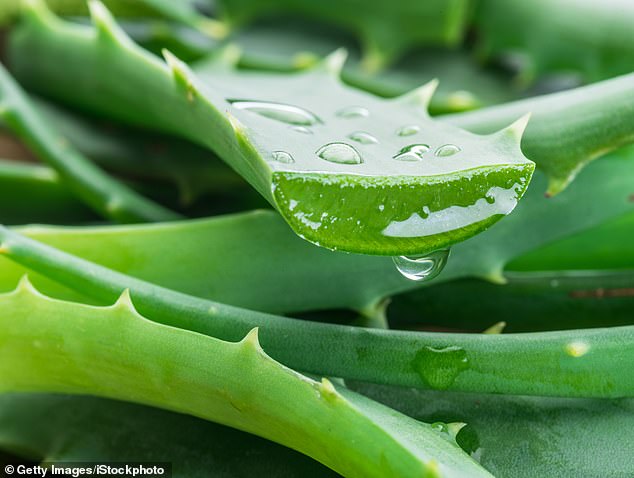Earlier this month, aspartame – the sugar substitute found in Diet Coke – was added to the World Health Organisation‘s list of more than 300 substances that ‘possibly’ cause cancer.
The WHO pointed out that the sweetener, also found in a wide range of foods, was still safe to use and the average adult would need to consume between nine and 14 cans of Diet Coke a day to exceed recommended limits. Even then, any risks were based on ‘limited scientific evidence’, which include decades-old animal research.
Scientists were quick to state that the results of these studies, which involved force-feeding lab rats large quantities of aspartame, were widely disputed.
Others attempted to reassure the public there was no cause for panic: after all, also on the same list of ‘possible’ carcinogens was aloe vera – the ubiquitous plant extract added to everyday skin-care products, supplements and even mouthwashes and toothpastes.
It was, no doubt, intended to show just how much of a non-issue this all was. But, in some cases, the claim simply added to anxieties.
‘Aloe vera is carcinogenic?’ wrote one concerned Twitter user.
‘Surprised to see aloe vera on the same list as lead, welding fumes and engine exhaust,’ commented another. ‘Does that mean I can’t use it for sunburn?’ Asked a third.
So what are the ‘risks’ of aloe vera – and should we be concerned it’s on a list of ‘possible’ carcinogens? The short answer is no, according to toxicology experts.
The cactus-like aloe vera plant has been used for centuries in traditional medicine, with ancient Greeks and Romans applying the translucent inner pulp to wounds.
Today, aloe vera extract has made its way into just about every sort of skincare product – from sunburn-relief gels and moisturisers to shampoos, soaps and even deodorants.
The global aloe vera extracts market is work roughly £1.2 billion – with demand rising every year.
However, there may be reason for caution if you intend to consume it, rather than just rub it on the skin. There is some evidence that a specific component of aloe – the yellow liquid sap found inside the leaves, between the outer ‘rind’ and inner pulp, known as aloe vera latex – could cause problems if eaten.
In 2013 researchers studying the toxic effects of aloe vera gave rats water containing varying concentrations of ‘aloe vera whole-leaf extract’, which contains aloe vera latex, for two years. After two years some of the rats fed the higher concentrations developed a rare intestinal tumour. The animals fed lower concentrations of aloe vera liquid did not develop these tumours.
Scientists believe compounds in aloe vera latex known as anthraquinones – which have a laxative effect and irritate the digestive tract – are responsible. Alongside the skin products, aloe vera extracts are also found in health food supplements – claimed to do everything from aid ‘detoxing’ to improving digestion – and drinks.
In light of the 2013 findings, the European Food Safety Authority issued a warning, advising against ‘long-term use and consumption [of anthraquinone-containing supplements] at high doses, due to potential safety concerns’.
And in 2019, it suggested a ban on certain aloe vera extracts known to contain the most harmful anthraquinones. Around the same time it was added to the WHO’s list of ‘possible’ cancer causes.
Alan Boobis, emeritus professor of toxicology at Imperial College London, says: ‘It’s a rare type of tumour they found in that 2013 study [investigating the effect of aloe vera on rats], which means they were pretty sure it was directly related to the substance the rats were consuming.
‘There is also evidence from other studies that anthraquinones cause damage to the DNA in cells that could lead to cancer.’
Interestingly, the same study found mice fed the same water did not develop the tumours. Prof Boobis says: ‘There is no evidence of a harmful effect in humans – but the studies we do have means the risk cannot be ruled out and that’s why it’s on the “possible” list.’
The WHO’s carcinogen lists, drawn up by its International Agency for Research on Cancer, is divided into categories.
Group 1 and 2A are substances known to be carcinogenic to humans or that are ‘probably’ carcinogenic, such as smoking, processed meats, asbestos, red meats and acrylamide – a compound produced when foods are ‘browned’ at high temperature.
Group 2B are ‘possible’ risks, because there is some evidence of cancer risk but it’s not strong. An example of this is when evidence is only drawn from animal studies, such as with aloe vera latex.
Aloe vera supplements and drinks on sale in UK shops are approved by the Government’s Food Standard Agency, so should have safe levels of anthraquinones, adds Prof Boobis.
However those who grow their own aloe vera – and scoop out the insides of leaves to add to smoothies – might want to consider that there could be dangers.
In higher concentrations, aloe vera, taken orally, can trigger diarrhoea and cramps.
There have also been individual case reports of heavy bleeding during surgery and of kidney and liver problems in patients who took aloe vera preparations. There are also suggestions that supplements may interfere with certain medications, such as blood thinners.
‘It’s a myth that “natural” is always safer or better for you,’ says Prof Boobis. ‘Some of the most toxic substances come from natural sources. Having said that, my main concern about health food products isn’t safety, it’s for many of them there is little convincing evidence for the positive effects claimed.’
It’s billed as a gut-friendly boost to any meal.
But trendy pickled Asian vegetables – such as Korean kimchi – is also on the WHO’s list of things that ‘possibly’ cause cancer.
These foods are made by adding large quantities of salt to vegetables, as well as sugar, spices and fish sauce. The mixture is then left to sit for several days to ferment, releasing lactic acid.
This acid is said to feed the healthy bacteria in our gut, leading to a host of benefits.
But studies show that countries where pickled vegetables are dietary staples, such as Korea and Japan, have higher rates of stomach and oesophageal cancer than nations that eat relatively little. One 2012 review of 60 studies said that regularly eating pickled vegetables was associated with a 50 per cent increased risk of stomach cancer, compared to those who ate them rarely or not at all.
This is thought to be due to the amount of salt which, during fermentation, converts substances called nitrates in the vegetables into nitrites – which have been linked to cancer. But pickling using vinegar and less salt is thought to interfere with the nitrates and is not associated with the same cancer risk.
Researchers also say that the link is not clear cut, as most of the evidence is based on observations rather than direct cause and effect. As the evidence is weak, it’s only a ‘possible’ cause and nothing more definite.










